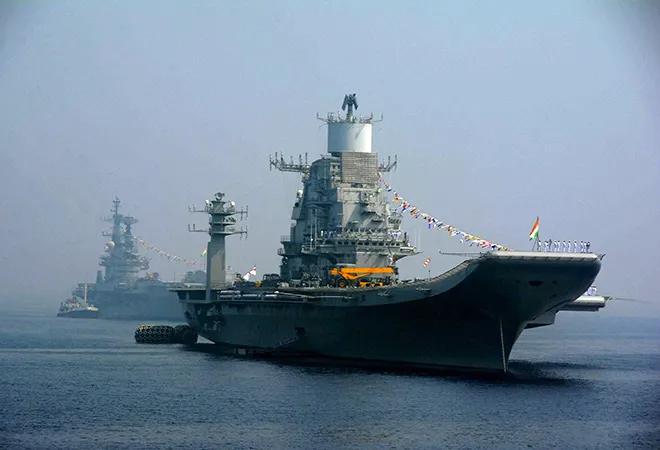-
CENTRES
Progammes & Centres
Location

Since Prime Minister Narendra Modi came to power, India has developed a distinct maritime outlook in its diplomacy and security policy. For years, there was a lack of political will to look toward India’s maritime interests. Modi’s leadership is now driving India’s maritime policy, reigniting hopes that India is finally waking up to the changes in Asia’s maritime domain.
The Indian navy released its new maritime strategy in October 2015, which emphasises international engagement and cooperation with regional partners. India also signed a Joint Strategic Vision for the Asia-Pacific and Indian Ocean region with the United States, a Special Strategic and Global Partnership with Japan and a Framework for Security Cooperation with Australia.
This comes amid practical steps such as India holding its first bilateral naval exercise with Australia in September 2015 and expanding its coordinated patrol with Indonesia to a bilateral naval exercise. New Delhi has also commissioned an Indian-built patrol ship for Mauritius and is boosting military and civilian assistance to its island neighbours. In Southeast Asia, India has provided a US$100 million line of credit to help strengthen Vietnam’s coastal defence, set up a satellite tracking and imaging centre in Vietnam and has strengthened maritime ties with Myanmar.
India has also voiced its concerns regarding maritime disputes in the South China Sea, an issue the previous government avoided. Modi has underlined the destabilising potential of disputes there through joint statements with the United States and Vietnam at the East Asia Summit and the India–ASEAN Summit both in 2014 and 2015. India even referred to the South China Sea as the ‘West Philippine Sea’, the Philippines’ favoured term, in a joint statement with Manila.
But India’s new outlook toward the maritime domain has come into confrontation with India’s traditional non-alignment policy. On the ground, India has arguably not made any fundamental shift away from its non-alignment commitments. Instead India is considering new avenues for engagement within the framework of its longstanding non-alignment policy. Balancing India’s desire to make a contribution to maritime security while maintaining its non-alignment policy will be a major challenge into the future.
India’s new enthusiasm in the maritime domain may have increased expectations from other regional and global powers that India will play a larger security role. Many countries, including the United States, welcome a greater security role for India in the light of changing geopolitics in both the South China Sea and the Indian Ocean. But from India’s perspective, moving too quickly is a genuine concern. India cannot afford to stretch its capabilities and blur the rules of engagement as far as non-alignment is concerned.
While India feels it is doing enough in the maritime domain, others may be concerned about what they see as the slow pace of India’s engagement. Whether India will deliver on its promises is a question of differences in threat perception, security interests, capability concerns and strategic gains between India and other regional powers. India’s new political will to engage with international partners will rely heavily on its own understanding of the potential strategic gains for India, rather than for the global security order at large.
The United States is for its part championing India playing a greater role in maritime security affairs. Washington’s defence strategy posited New Delhi as the lynchpin of the US pivot and the chief of its Pacific Command, Admiral Harry B. Harris, has proposed reviving the quadrilateral coalition — between the United States, India, Japan and Australia — as well as embarking on joint patrols with India in the South China Sea.
Australian leaders past and present
Amid expectations of greater Indian leadership, New Delhi is now increasingly conscious of its new maritime focus overlapping with its non-alignment policy. This explains India’s decision to keep portraying the Indian Ocean and the Asia Pacific as different strategic theatres in its joint vision with the United States and its hesitation to support officially upgrading the Indo–US MALABAR exercises to a trilateral format, despite continued participation from Japan. This caution too underlies India’s insistence that it will not patrol the South China Sea in the face of increased cooperation with the United States.
India remains absolutely adverse to the idea of a formal alliance. The Non-Aligned Movement kept New Delhi out of Cold War politics and allowed it to put forward its own concerns and interests as a rising power. It has kept India away from battles it is better off without. Although India is now ready to be an active security player, it has not yet reached a position where it can take drastic steps in changing the course of its foreign policy.
India is making steady progress in achieving the maritime goals it has laid out for itself. But India has to be careful not to eschew further engagement for fear that it implies a nascent security alliance. Engaging with regional navies is more in India’s favour than not and New Delhi should not allow the shackles of non-alignment to hold back its new maritime policy.
This commentary originally appeared in East Asia Forum.
The views expressed above belong to the author(s). ORF research and analyses now available on Telegram! Click here to access our curated content — blogs, longforms and interviews.